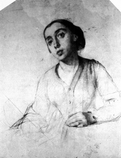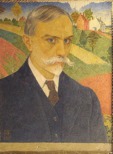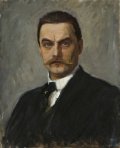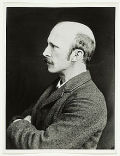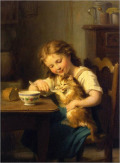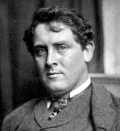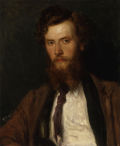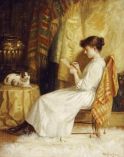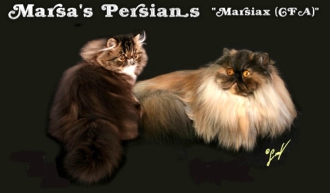
biography of the artists
source Wikipedia the free encyclopedia
John Duncan * Juli 1866 in Dundee; † 1945 in Edinburgh) war ein schottischer Maler, Illustrator, Glaskünstler und Designer des Symbolismus.
John Duncan war der Sohn des Lebensmittelhändlers William Gardiner Duncan und der Weberin Helen Thomson. Mit elf Jahren besuchte Duncan die Dundee School of Art. Später, vermutlich ab 1879, zeichnete er für die monatlich erscheinende sozialpolitische Comic-Zeitung The Wizard of the North. Gleichzeitig lieferte er Illustrationen für den Dundee Advertiser. Etwa 1885 siedelte er nach London um, wo er drei weitere Jahre als Buchillustrator tätig war. Duncan entschied sich für eine Karriere als Porträtmaler und besuchte kurzzeitig die Kunstschulen in Antwerpen und Düsseldorf, bevor er 1890 nach Dundee zurückkehrte. Im selben Jahr begann er seine erste Italienreise, die ihn über die Zwischenstationen London und Paris durch Rom, Florenz, Lucca, Bologna und Venedig führte. Vermutlich kehrte er im Frühjahr 1891 nach Schottland zurück.
1891 oder 1892 freundete sich Duncan mit dem Botaniker und Soziologen Patrick Geddes an. Zusammen mit William Gordon Burn-Murdoch lieferte er das künstlerische Material für dessen Seminare (“Summer Meetings”). Außerdem war er als Illustrator für die von Geddes gegründete Patrick Geddes Colleagues and Company tätig. Seine für die auf keltische Literatur und Kunst spezialisierte Zeitschrift The Evergreen (1895) angefertigten Arbeiten zeigen deutliche Einflüsse der japanischen Druckkunst. Außerdem beteiligte sich Duncan an Geddes’ Old Edinburgh School of Art, die ab etwa 1893 aktiv war, und bildete dort vier Mitarbeiterinnen aus. Er fertigte vor allem dekorative Kunstwerke und einige Porträts an. Enttäuscht war Duncan, als Geddes 1895 allmählich das Interesse an diesem Projekt verlor. 1896 oder 1897 wurde die Schule mangels ausreichend Kunden geschlossen, und 1898 kehrte Duncan nach Dundee zurück.
George Dunlop Leslie (* 2. Juli 1835 in London; † 21. Februar 1921 in Lindfield (Sussex)) war ein englischer Maler und Illustrator. Leslie, Sohn von Charles Robert Leslie, war anfangs Schüler seines Vaters, bezog dann 1854 die Akademie und stellte 1857 mit Erfolg sein erstes Bild Die Hoffnung aus, dem eine große Reihe anderer folgte, die in der Verbindung der Landschaft mit den Figuren ein tiefes Gefühl und große Anmut zeigen, aber in der Farbe oft weich und verschwommen sind.
Kawanabe Kyōsai (河鍋 暁斎?, May 18, 1831–April 26, 1889) was a Japanese artist, in the words of a critic, "an individualist and an independent, perhaps the last virtuoso in traditional Japanese painting".
Living through the Edo period to the Meiji period, Kyōsai witnessed Japan transform itself from a feudal country into a modern state. Born at Koga, he was the son of a samurai. His first aesthetic shock was at the age of nine when he picked up a human head apart from a corpse in the Kanda river.[3] After working for a short time as a boy with Utagawa Kuniyoshi, he received his artistic training in the Kanō school, but soon abandoned the formal traditions for the greater freedom of the popular school. During the political ferment which produced and followed the revolution of 1867, Kyōsai attained a reputation as a caricaturist. His very long painting on makimono "The battle of the farts" may be seen as a caricature of this ferment. He was arrested three times and imprisoned by the authorities of the shogunate. Soon after the assumption of effective power by the Emperor, a great congress of painters and men of letters was held at which Kyōsai was present. He again expressed his opinion of the new movement in a caricature, which had a great popular success, but also brought him into the hands of the police this time of the opposite party.
Kyōsai is considered by many to be the greatest successor of Hokusai (of whom, however, he was not a pupil), as well as the first political caricaturist of Japan. His work mirrored his life in its wild and undisciplined nature, and occasionally reflected his love of drink. Although he did not possess Hokusai's dignity, power or reticence, he compensated with a fantastic exuberance, which always lent interest to his technically excellent draughtsmanship.
Takeuchi Seiho
Lilly Martin Spencer (born Angelique Marie Martin) (November 26, 1822 – May 22, 1902) was one of the most popular and widely reproduced American female genrepainters in the mid-nineteenth century. She painted domestic scenes, women and children in a warm happy atmosphere. Although she did have an audience for her work Spencer had difficulties earning a living as a professional painter and was in perpetual state of financial turmoil.
Lilly Martin Spencer was born in Exeter, England to French born parents Gilles Marie Martin and Angelique Perrine LePetit Martin. In 1830, when Lilly was eight, her family immigrated to New York where they remained for three years before ultimately moving to Marietta, Ohio. There Lilly was home-schooled by her highly educated parents and began what would be her long career as an artist. Her first artistic endeavors were “likenesses of the entire household, in lifelike, characteristic postures, so truthful as to be recognized at once by everyone who knew them.] These likenesses were drawn on the walls of the family home. Rather than being scolded, Lilly was encouraged in her love of art by her parents, whose reformist tendencies—her mother was a follower of the Utopian advocate Charles Fourier—included a belief in more opportunity for women. She continued to draw and her work was so impressive that "ladies and gentlemen began to call frequently at the farm, to judge for themselves of these vaunted pictures. Their admiring comments stimulated her ambition and added to her industry; but the difficulty of procuring proper materials and the want of a competent teacher retarded her progress.
Yet she drew the attention of local artists and was mentored and helped, especially in coloring her charcoal drawings. One such mentor was Sala Bosworth who was a portrait and landscape artist who trained at the Pennsylvania Academy of Fine Arts. The second was Charles Sullivan (1794–1867) who had also studied at the Pennsylvania Academy of Fine Arts; his influence is very apparent in the early work of Lilly Martin. Martin's first exhibition in August 1841 was held at a church rectory, where she drew the attention of Nicholas Longworth, a benefactor of many artists. Of Lilly Martin, Longworth said “…a new genius has sprung up at Marietta of rather within five miles of it, at a farm house in the shape of a French girl of 17 or 18 years of age. She already has painted a great number of pictures. She is entirely self taught, excels in attitudes and designs.
Longworth offered to help Lilly financially and discouraged her from further shows until she had more training. This advice she ignored; instead, she along with her father traveled to Cincinnati for an exhibition in the autumn of 1841. Cincinnati was ”swarming with artists" and Lilly would spend the next seven years studying there. This would be the most highly productive period in her career, and is marked by her move from Cincinnati to New York, and ends with her move to New Jersey.] Lilly turned down Longworth's offer to send her to Europe to study; instead she received help and instruction from portrait artist James Beard and other local artists. She also received formal training from Mr. William. However the exact extent of her training is unknown. She produced her most well known and popular works during the decade between 1848 and 1858. Lilly was rare in the art world. Most women used art as genteel accomplishment and not as a career. Lilly, however, provides an example of a woman who pursued art as a career.
Arturo Cavicchini
Joseph Edward Southall (23 August 1861 – 6 November 1944) was an English painter associated with the Arts and Crafts movement.
A leading figure in the nineteenth and early twentieth-century revival of painting in tempera, Southall was the leader of the Birmingham Group of Artist-Craftsmen—one of the last outposts of Romanticism in the visual arts, and an important link between the later Pre-Raphaelites and the turn of the century Slade Symbolists.
A lifelong Quaker, Southall was an active socialist and pacifist, initially as a radical member the Liberal Party and later of the Independent Labour Party.
Southall was elected an Associate of the Royal Birmingham Society of Artists (RBSA) in 1898 and Member in 1902. He became President of the Society in 1939 and stayed in this post until his death in 1944.
Carl Larsson (* 28. Mai 1853 in Stockholm; † 22. Januar 1919 in Falun) war ein schwedischer Künstler.
Seine Gemälde, Aquarelle und Zeichnungen zeigen überwiegend das Leben seiner Familie (gemeinsam mit Frau Karin hatte Larsson acht Kinder) in und um das Wohnhaus in Sundborn, Schweden. Carl und Karin gelten als Begründer des heute als typisch schwedischgeltenden Wohnstils, dessen wesentliche Elemente Helligkeit, Farbigkeit und lebendig-fröhliche Funktionalität sind. Das Haus ist heute ein Museum. In Deutschland wurde Larsson ab 1909 berühmt durch das Buch „Das Haus in der Sonne“.
Carl Larsson wuchs in armen Verhältnissen auf. Als er 13 Jahre alt war, ermunterte ihn sein Lehrer zu einem Studium an der Königlichen Kunstakademie in Stockholm. Für die Bezahlung des Studiums war er gezwungen, nebenbei zu arbeiten. So war er z. B. als Retuscheur für einen Fotografen tätig. Nachdem ihm 1876 eine königliche Medaille zugeteilt wurde, ging es finanziell schon etwas besser.
Im Jahre 1877 konnte Larsson seine erste Reise nach Paris antreten. Seine dritte Frankreich-Reise führte 1882 in die Künstlerkolonie Grez-sur-Loing nahe Fontainebleau, wo er zahlreiche Aquarelle der umliegenden Natur anfertigte. Hier lernte er auch Karin Bergöö kennen, die bald seine Frau wurde. Das Paar kehrte anschließend für die Hochzeit nach Schweden zurück. „Dies war ein Wendepunkt in Larssons Leben. In Grez, Larsson malte einige der wichtigsten seiner Werke, jetzt aber in Wasserfarben, und sehr unterschiedlich zu der Ölfarbentechnik die er vorher benutzte“, heißt es in dem von Michael Snodin u. Elisabeth Stavenow-Hidemark herausgegebenen Buch „Carl und Karin Larsson - Ihr Leben und ihre Kunst...“.
Zwischen 1885 und 1888 malte er hauptsächlich Ansichten von Stockholm. Carl Larsson schloss sich der Künstlergruppe Opponenterna an, die bei der Kunstakademie eine Reform der Kunstausbildung forderte. Diese Forderungen wurden aber abgewiesen. 1886 wurde Larsson zusätzlich Vorsteher einer Kunstschule in Göteborg.
1888 bekam die Familie ein kleines Haus nahe Sundborn von den Schwiegereltern geschenkt. Das Haus wurde nach und nach handwerklich wie künstlerisch von Carl und Frau Karin ausgebaut, ausgeschmückt und erweitert und wurde unter dem Namen „Lilla Hyttnäs“ (etwa: kleine Hütte) bekannt. Das Haus wurde künstlerischer Mittelpunkt, die sieben Kinder (ein achtes starb kurz nach der Geburt) wurden hier großgezogen und, zusammen mit der Dorfgemeinschaft, auf zahlreichen für Larsson typischen Ölgemälden und Aquarellen verewigt. Das Haus ist bis heute als Familienmuseum originalgetreu erhalten und dient noch immer als Treffpunkt der Familie.
Nach einem weiteren Aufenthalt in Paris, wo unter anderem das Triptychon Rokoko-Renässans-Nutida Konst entstand, wurde er vom Nationalmuseum in Stockholm mit der Ausgestaltung der Innenwände dieses Gebäudes beauftragt. Ab 1896 malte er sechs Wände al fresco, wo unter anderem die Bilder Gustav Wasas Einzug in Stockholm am Mittsommerabend 1523 und Landgang von Gustav Adolf in Deutschland entstanden. 1896 erhielt er auf der Internationalen Kunstausstellung in Berlin eine kleine Goldmedaille.
Albert Gustaf Aristides Edelfelt (* 27. Juli 1854 auf Kiala gård bei Porvoo, Finnland; † 18. August 1905 in Haikko, Finnland) war ein finnlandschwedischer Maler und Graphiker.
Edelfelt studierte Malerei in Antwerpen und Paris, erhielt 1880 in Paris eine Auszeichnung für das Gemälde Ett barns likfärd (Leichenfahrt eines Kindes) und wurde 1881 in die Russische Kunstakademie - Finnland gehörte damals zu Russland - gewählt. 1895 wurde Edelfelt zum Vorsitzenden der finnischen Künstlervereinigung gewählt.
Edelfelt malte vor allem Szenen aus dem finnischen Volksleben. Zudem tat sich Edelfelt als Illustrator von Büchern hervor. Insbesondere zu Fähnrich Stahl von Johan Ludvig Runeberg gibt es von Edelfelt zahlreiche Illustrationen
Abbott Handerson Thayer (* 12. August 1849 in Boston, Massachusetts; † 29. Mai 1921 in Monadnock, New Hampshire) war ein US-amerikanischer Maler.
Nach seinem Schulbesuch kam Thayer nach New York, um dort zuerst an der Brooklyn Art School und später an der National Academy of Design Kunst zu studieren. Seine Lehrer waren dort die Maler H. D. Morse und Lemuel Wilmarth. Im Alter von 25 Jahren ging Thayer 1875 nach Paris und setzte sein Studium an der École des Beaux-Arts fort. Er blieb dort drei Jahre lang der Schüler von Jean-Léon Gérôme und Henri Lehmann.
1879 kehrte Thayer in die USA zurück und ließ sich als freier Maler in New York nieder. Sein künstlerisches Frühwerk bestand noch überwiegend aus Landschafts- und Tierbildern und war an der Schule von Barbizon ausgerichtet. Auch die Schriften von Ralph Waldo Emerson beeinflussten Thayer sehr. In New York wandelte er sich mit der Zeit zum gefragten Porträtisten. Eines seiner frühesten Porträts war „The sisters“, ein gefeiertes Doppelporträt von Clara und Bessie Stillman.
Die National Academy of Design in New York wählte ihn 1889 zu einem außerordentlichen Mitglied, 1901 wurde er ordentliches Mitglied. Gleich seinem Landsmann Douglas Volk, der ebenfalls Schüler von Jean-Léon Gérôme war, wurde Thayer korrespondierendes Mitglied der Accademia di San Luca in Rom.
1901 ließ sich Thayer mit seiner Familie in Dublin (New Hampshire) nieder. Dort, in ländlicher Abgeschiedenheit, lebte er mit seiner Ehefrau, der Blumenmalerin Emma und seinen Kindern Gerald, dem späteren Schriftsteller, Gladys, der späteren Miniaturenmalerin, und Mary, welche ihm öfters als Modell diente. In dieser Zeit führte Thayer längere Briefwechsel unter anderem mit Charles Lang Freer, Theodore Roosevelt und Mark Twain.
Zusammen mit seinem Sohn Gerald veröffentlichte Thayer 1909 „Concealing Coloration in the Animal Kingdom: An Exposition of the Laws of Disguise Through Color and Pattern“, in dem er Theorien zur Tarnung in der Tierwelt aufstellte, für die er vom ehemaligen Präsidenten der Vereinigten Staaten Theodore Roosevelt öffentlich hart kritisiert wurde. Später entwickelte er daraus Ideen für die Nutzung davon abgeleiteter Erkenntnisse im militärischen Kontext, die ab dem Ersten Weltkrieg Anwendung fanden.[1]
Als einer seiner wenigen Schüler ist sein Landsmann Ben Foster zu nennen.
Im Alter von 70 Jahren starb Abbott Thayer am 29. Mai 1921 in Monadnock. Thayer war einer der wichtigsten US-amerikanischen Maler seiner Zeit.
Frederick Morgan (1847/1856 - 1927), was an English painter of portraits, animals, domestic and country scenes. He became famous for his idyllic genre scenes of childhood.
Morgan was born in London. He was commonly known as Fred Morgan and was the son of John Morgan, a successful genre artist sometimes known as 'Jury Morgan' (after one of his paintings The Gentlemen of the Jury). At the age of fourteen he was taken out of school by his father who then tutored him in art. At the age of 16, while still studying with his father, his first picture, The Rehearsal, was exhibited at the Royal Academy, and, after a hiatus of several years, his paintings were shown there regularly. For a while he worked as a portrait artist for an Aylesbury photographer, - this training proved to be crucial as it "taught him how to observe closely and to give the greatest attention to detail."
Eventually he turned to other subjects for his art, in particular idyllic genre scenes of country life and childhood. For many years, starting in 1874, Thomas Agnew & Sons' purchased all the work he produced. Over this period he painted some of his most popular works such as The Doll’s Tea Party (1874), Emigrants' Departure (1875) and School Belles (1877). Most of his painting was done in the village of Shere close to Guildford, a well-known retreat for artists. He also painted in Normandy, including Midday Rest (1879) and An Apple Gathering (1880).
Although an excellent portrait artist, Morgan had problems in depicting pets and barnyard animals - he enlisted the aid of either Arthur John Elsley or Allen Sealey (1850–1927) when such problems needed resolving.
He is known mostly for his romantic and sentimental paintings of children in the same style as his contemporary Arthur John Elsley. His paintings achieved great popularity in his lifetime and were widely published. He exhibited with the Royal Academy and was a member of the Royal Institute of Oil Painters
John Charlton (1849–1917) was an English painter and illustrator of historical and especially battle scenes, mainly from contemporary history.
Born to Samuel Charlton and his wife Mary Ann (née Pickering) Charlton on 28 June 1849, in Bamburgh, Northumberland, he received his first lessons in drawing from his father when he was only three or four years old, and within a few years was drawing horses with some skill. Due to his family’s financial misfortunes, he had to attend Dr. Sharp’s charity school held in Bamburgh’s great castle, and a few years later, was forced to quit and find employment. A job in the Newcastle bookshop of Mr. Robinson, a keen collector of the work of Thomas Bewick, "the father of wood engraving,” gave him an appreciation of graphic art. It was here that the budding artist began to imitate the master’s work, much to the delight of two of Bewick’s ageing sisters. Later he spent seven monotonous years employed in the office of Sir Isaac Bell’s ironworks, but seeing the young man’s skill at draughtsmanship, his employers regularly granted him one day a week in which to practice his art. Mr. Joseph Crawhill suggested that he attend evening classes at the Newcastle School of Arts under William Bell Scott. During this time he began to develop quite a reputation on Tyneside as a painter of horses and dogs, and he received some commissions to portray family pets.
He debuted at the Royal Academy in 1870, and his first painting with a military theme, Exercising artillery horses on a frosty morning, appeared three years later. Realising that his best prospects for advancement lay in the London art world, he ventured south in 1874 and took classes at the South Kensington Museum, now the Victoria and Albert Museum, under J. D. Watson. While he settled in the capital, he never forgot his northern roots, maintaining a house at 24 Windsor Terrace, Newcastle, and at one time lived at Cullercoats, while his final years were spent at Lanercost in Cumbria.
The late 1870s and 1880s were a very busy time for British and colonial forces as they tried to consolidate colonial hold over possessions in northern and southern Africa. Many of the illustrations appearing in The Graphic depicting these events came from the hand of Charlton, especially during the Egyptian Campaign of 1882, when he had to draw-up many of the eye-witness sketches posted to the paper by its 'special artists' as well as soldiers. It was also during 1882 that he married Kate, daughter of Thomas Vaughan, J.P. of Ugthorp Lodge, Cleveland.
Antoine Jean Bail
Hans Heinrich Schlimarski (1859 – 1913) studierte an der Wiener Akademie unter August Eisenmenger. Später wurde er Privatschüler des berühmten Malers Hans Makart und komplementierte seine Ausbildung durch zwei Studienreisen nach München und Italien. Zu seinen Spezialitäten gehörten Auftragsarbeiten für Kunstverlage und Pastellportraits. Das Hauptwerk von Schlimarski, “Shakespeare am Hofe der Königin Elisabeth“ befand sich im Besitz von Friedrich I, ehemaliger Großherzog von Baden.
Sidney Lawrence Brackett( 1852-1910) was born in Boston and studied under John B. Johnson and Frederic Porter Vinton. He was a member of the Boston Art Club, where his work appeared in exhibitions throughout the 1890s and into the first decade of the twentieth century. Brackett is best known for his detailed and lifelike animal paintings, which remain among the most outstanding American examples of a genre largely lost today. He successfully combined realism with the 19th century sensibility toward the small pleasures of domestic life, which in Victorian times included portrayals of children and family activities as well as family pets. These paintings are invariably of great charm and humor, presenting dogs, cats, puppies and kittens in amusing and engaging situations. It is a testament not only to Brackett's technical skill, but to his ability to observe his subjects with a certain objective distance that he achieves these scenes without the cloying sweetness found in so much of this genre at the hands of lesser artists. Though Brackett also painted tavern, hunting, and harbor scenes, it is for his special understanding of animals that his works are most prized today
John Henry Henshall, usually known as Henry Henshall (1856–1928) was an English painter and etcher and a member of the Royal Watercolour Society
Henshall was born in Manchester. Leaving school at the age of sixteen, Henry - he preferred his second forename to that of John - attended the Manchester School of Art, where he was taught by William Jabez Muckley, who was a talented but demanding master. In March 1876 he travelled to London to join the South Kensington School of Art, but he remained there only one term, passing in the following June to the Royal Academy on the special recommendation of Edward Poynter. In 1880 he was awarded a Royal Academy silver medal for a Painting of a Head from the Life, almost certainly the fine watercolour An Egyptian Muleteer now in the collection of the Victoria and Albert Museum.
Although Henshall did paint some oils he was principally a watercolourist, being elected an Associate of the RWS in 1883, and becoming one of the Society's forty full members in 1897. He exhibited 171 pictures at the RWS and his diploma work, La Serenata, may be viewed at the Society's Bankside gallery. A favourite theme of Henshall's work is the contrast between the happy innocence of childhood, without cares, and the tribulations of old age. He was not afraid to tackle uncomfortable subjects and his honest, realistic pictures of ordinary life were quite unusual for painters in the Victorian era. In April 1912 the Leicester Galleries in London had an exhibition of Henshall's watercolours of Country Folk (catalogue No. 162).
Henshall died in Bosham, near Chichester, on 18 November 1928, aged 72.
Fritz Zuber-Buhler (1822 – November 23, 1896) was a Swiss painter in the style of Academic Classicism, born at Le Locle in Switzerland.[1]
At sixteen years of age he moved to Paris, France where found his first teacher, Louis Grosclaude. Later he studied at the “École des Beaux-Arts” and then refined his technical skills with François-Édouard Picot, who followed the same lineage of contemporaneous artists such as Léon Perrault, Bouguereau, and Alexandre Cabanel. Afterwards he spent some time in Italy searching for inspiration; he may have also studied in Berlin. After five years abroad, he returned to Paris, where he made his debut at the Salon in 1850. In subsequent Salons he showed works in many media: oil paintings, drawings, pastels and watercolors.
His painting Innocence shows his romantic view of the peasant children and their environment. He painted mythological and religious subjects, as well as commissioned portraits. Zuber-Buhler exhibited in the United States at the Pennsylvania Academy of the Fine Arts and achieved considerable success. He exhibited at the Salon (Paris) until 1891, by which time the European academic tradition he represented was past its heyday
Leo Malempré
Julian Alden Weir (* 30. August 1852 in West Point, New York; † 8. Dezember 1919), häufig nur als J. Alden Weir bekannt, war ein US-amerikanischer Maler des Impressionismus
John Alden Weir war der Sohn des Malers Robert Walter Weir, der zudem Professor an der Militärakademie war. Auch sein Bruder John Ferguson Weir war Maler und leitete von 1869 bis 1913 die Yale University School of Fine Arts. Seine erste künstlerische Ausbildung erhielten beide Brüder bei ihrem Vater, Julien Alden Weir ging anschließend an die National Academy of Design nach New York City und studierte dort Malerei.
Von 1873 bis 1877 reiste er nach Europa, um in Paris weiter zu studieren. Hier wurde er vor allem von Jean-Léon Gérôme ausgebildet. 1875 konnte Weir mit A Britanny Interior sein erstes Gemälde im Pariser Salon ausstellen, bei dessen Motivwahl er sich von seinem Freund Jules Bastien-Lepage inspirieren ließ. Weir lehnte zu dieser Zeit sowohl die Kunst der französischen Impressionisten als auch die Malerei von James McNeill Whistler ab, bei denen er zu wenig Form und Zeichnung kritisierte. Whistler selbst lernte er 1877 in London persönlich kennen.
Im Herbst 1877 kehrte Weir in die USA zurück und ließ sich in New York City nieder, obwohl er auch in den späteren Jahren regelmäßig nach Europa reiste. Im gleichen Jahr war er einer der Gründer der Society of American Artists, deren Präsident er 1882 wurde. Im Jahr 1878 begann er mit der Ausbildung anderer Künstler, zuerst an der Cooper Union, später an der Art Students League. Seine eigene Malerei konzentrierte sich zu dieser Zeit auf die Porträt- und Genremalerei. Besonderen Anklang fanden seine Blumenstillleben sowie die so genannten Bric-a-bracs, die mit denen von John Le Farge verglichen wurden. Ab 1883 pendelte Weir zwischen seiner Stadtwohnung in New York und seiner Farm in Branchville in Connecticut. Inspiriert durch die Bilder Édouard Manets sowie eine Ausstellung französischer Impressionisten in New York 1886 wendete er sich nun auch diesem Kunststil zu, indem er erste impressionistische Landschaftsbilder mit kurzen Pinselstrichen produzierte. Besonders in Branchville entstanden entsprechend viele dieser Landschaftsbilder und 1887 ließ sich dort auch Weirs Freund John Henry Twachtman nieder. Ab 1887 begann Weir zudem, sich stärker auf die Druckgrafik und Kaltnadelradierung zu konzentrieren.
Ludwig Knaus (* 5. Oktober 1829 in Wiesbaden; † 7. Dezember 1910 in Berlin) war der erfolgreichste Wiesbadener Maler im 19. Jahrhundert. Frühe Berühmtheit erlangte er als Genremaler, ebenso als Porträtist. Darüber hinaus war sein Können auch in der Werbebranche gefragt. Um 1900 hatte er als Maler einen so hohen Stellenwert erreicht, dass ihm das Große Konversations-Lexikon Meyers eineinhalb Spalten widmete und resümierte: „Die echt deutsche Richtung seiner Kunstanschauung gipfelt in der Schilderung des Kinderlebens [...] Seine Bilder haben durch Stich und Photographie eine große Popularität erreicht. Er ist Professor, Mitglied der Akademie, Ritter des Ordens pour le mérite und seit 1861 im Besitz der großen Medaille der Berliner Kunstausstellung.“ Zu seinem 100. Todestag im Jahr 2010 gedachte man seiner in seiner Geburtsstadt: „Den bedeutendsten Wiesbadener Künstler hat die Kunstgeschichte nicht bewältigt. Auch er zählt hier zu den großen Toten.“
Charles Zacharie Landelle (* 2. Juni 1821 in Laval; † 13. Dezember 1908 in Chennevières-sur-Marne) war ein französischer Maler.
1825 zog die Familie nach Paris, nachdem sein Vater, ein Kaliograph und Musiker, dort eine Stelle als Musiker in den Tuilerien gefunden hatte. Ary Scheffer ermutigte ihn zur Malerei und Charles Landelle schrieb sich am 2. Oktober 1837 als Schüler von Paul Delaroche an der École des Beaux-Arts ein. Sein Ausstellungsdebut hatte er 1841 mit Selbstportraits und religiösen und historischen Gemälden, die in ihrer weichlichen, empfindsamen Auffassung an seinen Entdecker Ary Scheffer erinnerten.
Er malte nun auch religiöse Bilder für die Pariser Kirchen St. Roch (1850), St. Germain l’Auxerrois (1856) und St. Sulpice (1875).
Landelle gilt auch als ein Vertreter des Orientalismus. Nachdem er ab 1865 Reisen in den Mittleren Orient und Nordafrika unternommen hatte, entwickelte er eine Spezialität in der Darstellung von Einzelfiguren, die sich jedoch mehr durch Sentimentalität denn durch ethnographische Wahrheit auszeichneten. Er bereiste Marokko, Algerien und Ägypten und fuhr mit dem Ägyptologen Auguste Mariette nilaufwärts. Von den Bildern dieser Art sind besonders: Die Armenierin vom Kaukasus und Die Almeh von Kairo und das Fellahmädchen, letzteres auch in Deutschland durch den Stich von R. Stang, populär geworden. Er hat auch zahlreiche dekorative Malereien, Allegorien und Porträts ausgeführt, wobei seine Malweise glatt und ohne Energie ist.
Philip Richard Morris (4 December 1836 in Devonport – 22 April 1902 at 92 Clifton Hill, Maida Vale, London) was an English painter of genre and maritime scenes (particularly allegorical ones of rural life), Holman Hunt-influenced religious paintings and (later in his career) portraits.
Taken to London aged 14 by his iron-founder father to train for the family trade, Philip became increasingly interested in art and, with William Holman Hunt winning round his father, began taking evening drawing classes in the British Museum and (from 1855) in the Royal Academy Schools. At the latter, he used the travelling studentship he won for his The Good Samaritan to fund a journey to Italy and France, remaining there until 1864.
He was elected an associate of the Royal Academy in 1877 (despite his talents and health already being on the wane), though he resigned it in 1900. In 1878 he married a widow, Catherine Sargeantson, the daughter of J. Evans of Llangollen, they had two sons and three daughters. Catherine died in 1886, his daughter Florence married the archaeologist Alexander Keiller and his eldest daughter, Gladys Morris (1879–1946), married the noted British sportsman, journalist and editor, Bertram Fletcher Robinson
George Elgar Hicks (* 13. März 1824 in Lymington, Hampshire; † 4. Juli 1914 in Odiham, Hampshire) war ein englischer Maler.
Hicks studierte erst Medizin und wechselte später zur Malerei. Aus diesem Grund besuchte er ab 1843 die Kunstschule von Bloomsbury und wechselte im darauffolgenden Jahr an die Royal Academy of Arts in London. 1855 schaffte er dann mit seinem Gemälde Horch, die Lerche, singt am Himmelstor seinen künstlerischen Durchbruch.Hicks Bilder sind der Genremalerei zuzuordnen und zeigen fast ausschließlich Szenen aus dem Volksleben
Adolf von Becker (1831, Helsinki – 1909, Vevey, Switzerland) was a Finnish painter.
Adolf von Becker was a realist painter and one of the first Finnish artists to receive training in France. In Paris he was a pupil of the realist innovator Gustave Courbet. Becker opened his own school in Finland where he taught painters such as Helene Schjerfbeck, Albert Edelfelt and Akseli Gallen-Kallela.
Federico Andreotti (Florence, March 6, 1847-1930) was an Italian painter.
He initially studied with Angiolo Tricca, Stefano Ussi, and at the Florentine Academy of Fine Arts. At a contest, he won a stipend and ultimately gained appointment as professor at the Academy. He was prolific as a painter of canvases at Rome, Florence, and other cities. He painted realistic genre and aristocratic scenes, often in dress from the eighteenth centuries. The elaborate period dress and affected airs give his paintings, sometimes described as Rococo Revival, a retardataire focus.
De Scott Evans (eigentlich: David Scott Evans; * 28. März 1847 in Boston; † 4. Juli 1898 im Atlantischen Ozean auf einer Reise von New York nach Paris) war ein US-amerikanischer Maler, der vor allem als Genre- und Porträtmaler tätig war. Besondere Aufmerksamkeit erhielt er im späten 20. Jahrhundert aufgrund der Zuschreibung zahlreicher Bilder im amerikanischen Trompe-l’œil-Stil, die er unter mehreren Pseudonymen gemalt haben soll.
David Scott Evans wurde 1847 als fünftes von sechs Kindern des Landarztes David Souder Evans und dessen Frau Nancy A. Evans (geb. Davenport) geboren. Seine erste offizielle künstlerische Ausbildung erhielt er 1864 im Atelier des Malers Albert Beaugureau in Cincinnati. In den ersten Jahren seiner beruflichen Laufbahn arbeitete Evans als Lehrer, 1872 heiratete er Alice Josephine Burke aus Ohio, mit der er später zwei Töchter hatte, Mabel und Nancy. Das Paar adoptierte zudem eine dritte Tochter, Laura. Im gleichen Jahr hatte er eine Anstellung als Lehrer für Kunst und Musik am Smithson College in Logansport, Indiana, und von 1873 bis 1875 leitete er die Abteilung für schöne Künste am Mt. Union College in Alliance, Ohio.
1874 zog Evans gemeinsam mit seiner Familie nach Cleveland, Ohio, und gründete dort ein Atelier, um sich verstärkt der Malerei zu widmen. Er arbeitete unter seinem Künstlernamen De Scott Evans, den er in Alliance erstmals benutzt hatte und wurde der erste Lehrer des späteren Impressionisten Otto Bacher. Seine eigene Ausbildung führte Evans 1877 nach Paris, wo er bei dem akademischen Maler William Adolphe Bouguereau studierte. Nach dieser Ausbildung etablierte er sich als Porträtmaler und war 1882 Gründungsmitglied der Cleveland Academy of Art.
Bereits seit 1881 stellte Evans regelmäßig bei den Ausstellungen der National Academy of Design aus und 1887 zog er nach New York City und trat dem zu seiner Zeit angesehenen Salamagundi Club bei. 1898 reiste er erneut nach Paris, um einen Auftrag zu übernehmen, erreichte sein Ziel jedoch nicht, da der französische Passagierdampfer La Bourgogne am 4. Juli auf der Überfahrt ein anderes Schiff rammte und unterging; De Scott Evans ertrank gemeinsam mit seinen drei Töchtern. Seine Frau Alice war nicht an Bord.



